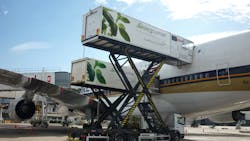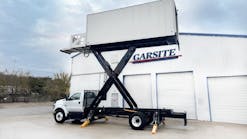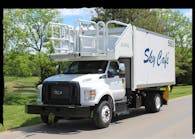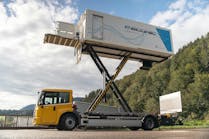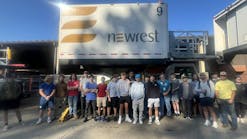As the airline industry readied for the Airbus A380 to begin operation in 2007, officials at Mallaghan GSE were working out solutions to service the wide-body aircraft, including methods for reaching the aircraft’s higher door sills.
“It took a lot of time on the drawing board,” said Niall Mallaghan, director at Mallaghan GSE.
While the lower deck of the A380 is the same sill height to service as the A330 aircraft, Mallaghan officials had to develop a unit that raised another 2.5 meters to service the upper deck of the A380.
To accomplish the feat, Mallaghan developed the CT8000 catering truck.
“Our conventional CT6000 is a two-axle truck. We were going to a three-axle truck because we had a longer height to reach, so we needed longer scissors. We had a heavier payload to lift, so we needed extra gross vehicle weight (GVW),” he added. “For us, that was new. So that was a good starting point.”
Mallaghan engineers began their initial designs in 2005. In 2006, the company began building its first truck on a European Mercedes chassis and brought the unit the Toulouse, where Airbus had a testing location.
The extra height and the additional payload required to lift additional food trolleys provided its own challenges. But once the van body was raised to full height, there was a 3-meter space between the front of the truck and the fuselage.
“Whenever you’ve lifted the truck up to maximum height, you can’t raise the stabilizers and drive towards the aircraft. What we had to do then, was invent a method of rolling the body forward, which we did,” Mallagan explained. “So, the body transferred forward another 3 meters until it came in contact with the fuselage.”
Properly docking to Door 5 of the Airbus A380, located near the wing, also proved challenging.
“We then had to transfer the front-loading compartment a half a meter to the left, so we could completely dock onto Door 5. That meant that we could securely deliver food onto every single door of the A380 or carry out cabin cleaning servicing on every door of the A380,” Mallaghan said.
After testing at Toulouse twice in 2006, Mallaghan received approval from Airbus to service the aircraft with the CT8000.
“At that point, we could market and go to potential customers anywhere in the world that was going to be flying,” Mallaghan said.
Safety for Operators
Because the CT8000’s van body is longer than the company’s conventional truck, additional stability calculations were required to ensure the truck wouldn’t blow over in high winds while raised.
“To do that, we incorporated, on the chassis of the truck, stabilizers that extend out 1 meter past the side of the truck before they go downward and make contact with the ground. Therefore, you’re giving the truck all the stability it needs to raise 8 meters and meet all wind calculations, so you that you can do it safely for the workers,” Mallaghan said.
To further enhance safety for ground service providers, a sliding canopy was integrated on the roof. Once the platform is extended and connected, the canopy protects workers from weather and side panels on the platform help protect against vertigo.
“It made an airbridge effect. Therefore, when you’re walking in and out of the aircraft, you couldn’t see down so don’t really know you’re at 8 meters,” Mallaghan said. “It made the operators feel much more safe and secure in that environment.”
Safety for Aircraft
The controls located in the van body require the operator to follow the proper procedure of raising the van body to 8 meters, transfer the body forward 3 meters and then traverse the platform a half meter to the left.
“You can only do them in that order. And then you extend the platform forward,” Mallaghan explained. “The same thing happens for coming off the aircraft. The buttons are in the proper sequence, but also the buttons are safely interlocked that you can’t automatically just come downwards.
“You must retract the platform first. Then you must transverse to the right to bring the platform to the home position. Then you must traverse the van body back 3 meters before you can come down,” he added. “Once you have one operation complete, the button that you’re pressing would light up to let you know you’ve completed that operation and you can go on to the next operation.”
As the aircraft is being loaded with cargo, catering supplies, fuel and passengers, the additional weight will cause the aircraft to move downward. When this happens, a safety shoe on the platform automatically moves the van body lower by a preset distance of 4 inches at a time.
The CT8000 was first equipped with cameras to assist with positioning the vehicle next to the aircraft and sensors, and the platform bumpers were fitted with sensors to automatically stop the platform from moving forward and making contact with the aircraft.
Since its original launch in 2007, Mallaghan’s Collision Avoidance System has been developed and is an optional feature.
The system puts the vehicle into “creep speed” as it begins to approach the aircraft. When the vehicle is within 1 meter of the aircraft, it goes into snail speed, limiting the speed to 2 km/h.
“Once it gets to the position of where you’re within 100 mm or 4” off the aircraft, it automatically deploys the handbrake so that you cannot move the truck forward, no matter what you do,” Mallaghan said.
“The same cameras take over when you raise the van body,” he continued. “Whenever you’re bringing the platform against the aircraft, as soon as the sensors read you’re 4” from the aircraft, it stops any forward movement so you can’t damage the aircraft.”
Additional Uses
While the CT8000 is capable of servicing the Airbus A380, it can also be used as a conventional catering truck, raising up to 6 meters.
However, because the vehicle is capable of extended reach, ground handlers servicing A380s have found the vehicle can be of use for cabin cleaning services and assisting passengers with reduced mobility (PRM).
The CT8000 can be found most airports where the A380 flies. Because of this, Mallaghan provides customization to meet an individual customer’s needs.
“No two customers are the same in their requirements for a truck. In Europe, we obviously have to fit a European chassis underneath with the emission levels that are required in Europe. The Middle East has a separate set of criteria, again as does North America,” Mallaghan said. “Whilst the scissors and the van body look the same, what’s underneath – the power supply or the chassis supply – is different.”
What’s more, some customers may require refrigeration to bring the van body temperature down to 4 degrees and below. Some operators may require a tail lift on the rear for loading and unloading food trollies. Some operators prefer an electric-style door.
“Even if you look at the cabin of the catering truck, depending on the destination of where it’s going to, and the temperatures it has to work in, Mallaghan manufacturers panels on for the sides, the roof and the floor of the truck,” Mallaghan noted. “If it’s going to a very warm climate like in Saudi Arabia, that panel will be 4 inches thick. But if it’s going to a standard climate in the UK, that panel could be 2 inches or 3 inches thick.
“Then again, if it’s only for cabin cleaning, it’s only a 2” panel anyway. There’s lots of factors you need to take into consideration when designing the truck to give the customer the performance they need from it.”
He added PRM vehicles need to be equipped with air conditioning in the van body, hand grips inside and tracking on the floor to secure the wheelchairs as well as seating for traveling companions.
“It’s building the right specification for a customer’s needs,” Mallaghan said.
